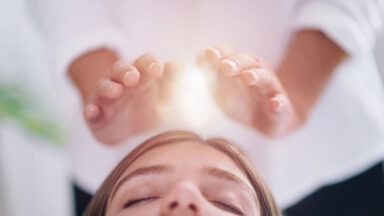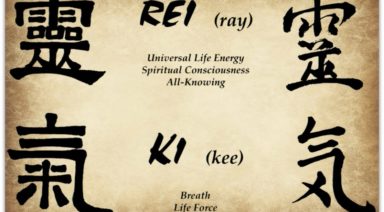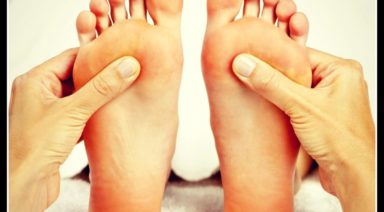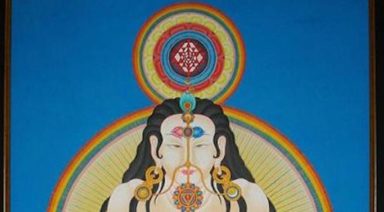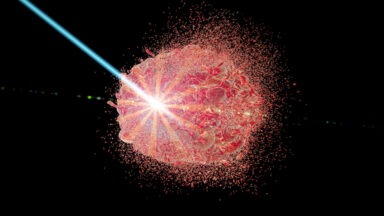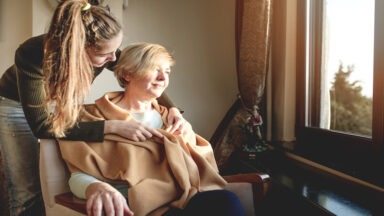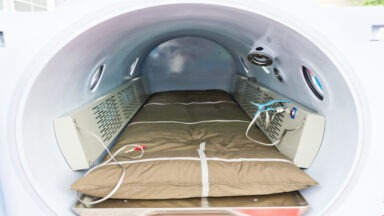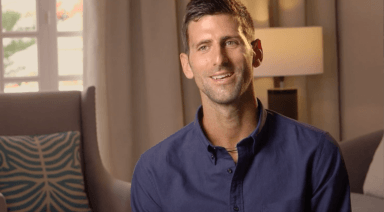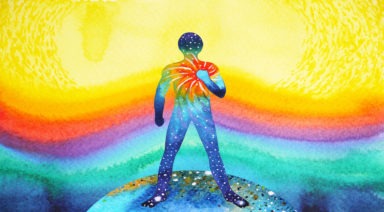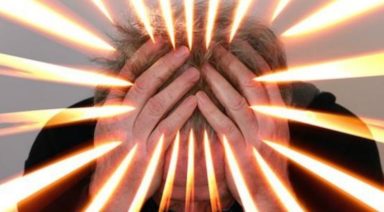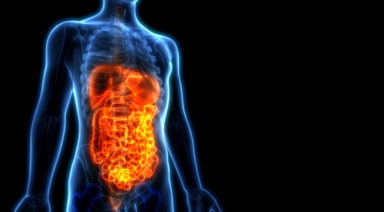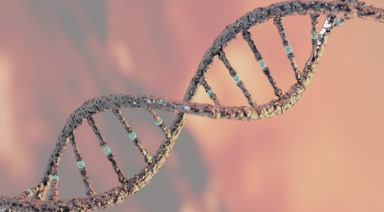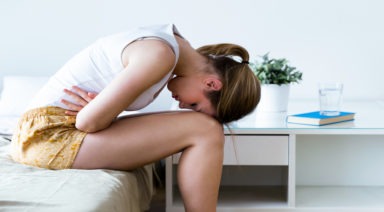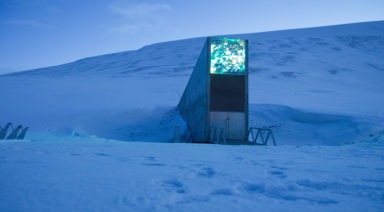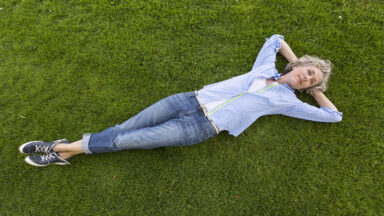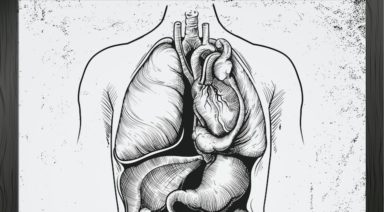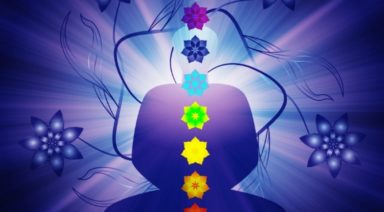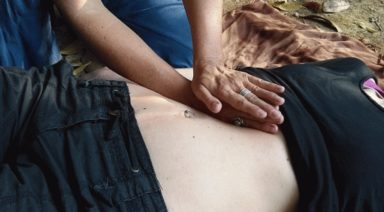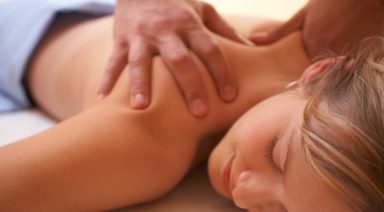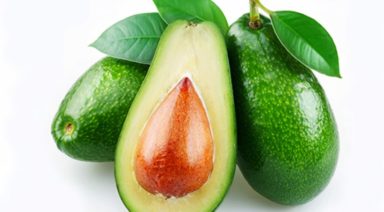The Benefits of Going Barefoot

Ever notice how you feel so energized and vibrant while walking on the beach? You probably attributed that to being on a beach vacation where your stress literally evaporated upon sinking your toes in the silky sand, inhaling that salty ocean air and soaking up some vitamin D elixir from the sun’s healing rays, right? Well that’s partially true. But there’s something else going on that’s creating this optimal state of health. What’s the magical ingredient? Electrons.
Our feet contain a rich, intricate network of nerves and acupuncture points and are especially adept at picking up free electrons from the earth’s surface. It’s called barefoot or caveman medicine, and walking barefoot – aka earthing or grounding – may be the easiest, simplest and cheapest way of shifting your body back to an optimal state of homeostasis and health.
Electrons: The Missing Link
The gist of the earthing theory is simply this: the earth is negatively charged, so when you ground, you’re connecting your body to a negatively charged supply of energy. And since the earth has a greater negative charge than your body, you end up absorbing electrons from it. These free electrons intercept the firestorm of free radicals (that create oxidative damage and inflammation) in our body and extinguish this fire. When you walk barefoot, you’re literally soaking up millions of electrons that decoagulate and detoxify your blood. So instead of your blood being all viscous and thick, like ketchup, it becomes free flowing, like red wine. Earthing also shifts the sympathetic nervous system back to the point where it has more tranquility, and clinical studies have shown that earthing helps with everything from inflammation to insomnia, and from autoimmune to heart disease.
Benefits
You may find that walking barefoot on either moist grass or the beach immediately produces a warm, tingling sensation or a sense of well-being. This contact can trigger health benefits, often within minutes. These benefits include relieving muscle tension, headaches and menstrual symptoms. Earthing can also boost the immune system, combat inflammation, reduce stress hormones and improve blood pressure. For people who are ill – and therefore have the most free radicals – the benefits can be dramatic. Those who are healthy usually report sleeping better and having more energy.
A report in the Journal of Alternative and Complementary Medicine confirmed these benefits:
“It is well established, though not widely known, that the surface of the earth possesses a limitless and continuously renewed supply of free or mobile electrons as a consequence of a global atmospheric electron circuit. Wearing shoes with insulating soles and/or sleeping in beds that are isolated from the electrical ground plane of the earth have disconnected most people from the earth’s electrical rhythms and free electrons.”
“A previous study demonstrated that connecting the human body to the earth during sleep (earthing) normalizes the daily cortisol rhythm and improves sleep. A variety of other benefits were reported, including reductions in pain and inflammation. Subsequent studies have confirmed these earlier findings and documented virtually immediate physiologic and clinical effects of grounding or earthing the body.”
The concept of earthing is gaining momentum today because of the efforts of Stephen Sinatra, MD, a holistic cardiologist, and Clinton Ober and Martin Zucker, coauthors of Earthing, a new book about the health benefits of grounding.
For Dr. Sinatra, earthing is the most important health discovery made in his 40 years of practicing medicine. He believes that modern life has disconnected us from the earth in many ways. We live and work in multistory buildings high off the ground and spend our nights on thick mattresses far from the earth. This separation from the surface of the earth reduces our connection to its charge, which has resulted in our bodies being deficient in electrons, says Dr. Sinatra.
At the same time, modern life has brought with it a host of medical conditions associated with chronic inflammation, including heart disease, diabetes, arthritis and cancer. As Dr. Sinatra and his colleagues see it, inflammation in the body is out of control, mainly because we have lost contact with the earth. What a fascinating concept!
How to Get Grounded
Simply slip off your shoes and plant your bare feet in the ground for thirty minutes. When you first start adopting a barefoot lifestyle, it’s best to initiate on naturally softer grounds like grass, dirt paths and sand (instead of cement, asphalt or hardwood). When the muscles and joints of your foot become more stable, and the skin on the bottom of your feet thickens, you’ll be able to handle progressively more time barefoot, and on a wider variety of surfaces. Although walking, wading or swimming in mineral-rich ocean water is ideal (oceans are highly conductive, more so than lakes), the key is to have direct, sustained skin contact (any part of your body will do) with the surface of the earth. This is why gardening, where you put your hands in and out of the earth, does not provide quite the same benefit.
Some Dos & Don’ts:
- Do walk on grass that is slightly moist, as the water helps conduct the electrons; dry grass won’t be as effective
- Don’t walk on grass or soil that is littered with dirt, dog/bird droppings etc. Because the soles of our feet are very effective at absorbing the earth’s energy, they can also absorb toxins — use commons sense before you ditch your shoes. Pristine forest or beach soil is ideal
- Do ground, especially after flying, as our bodies bioelectrical rhythms are thrown out of balance in flight and grounding restores that electrical equilibrium
- Do wash your feet with soap and water, after grounding, to get rid of soil detritus that you may have picked up
- Don’t go barefoot if you have any open cuts/sores on your soles, as that can be an entry point for parasites/fungi
Grounding: Radical Discovery or Hippie Hoax?
They say the most radical ideas are the most simple ones but, I must confess, after perusing through all this grounding literature, it seemed too good to be true. Does grounding really work or is it something dreamed up by barefoot radical hippies?
I decided to toss my inhibitions about parasites and calloused feet (along with my trusted flip flops), and give this barefoot medicine a real try. The truth is that I’ve been going through an egregious period of stress with my mom’s lung cancer diagnosis, and have been on an insatiable quest to discover new stress relieving strategies that I can add to my go-to stress toolbox when I’m practically ready to tear out my hair! And I figured, why not give this a try for a month?
A yoga teacher suggested this barefoot medicine, attesting to the sense of grounding it has provided her, “We need to feel the earth – to contact it, to connect to it directly. It brings us back into ourselves and reminds us of our place.”
Impelled, I went home, kicked off my sandals, and set afoot. I took each step slowly, consciously, deliberately. I’ll admit that at first it was because I was afraid of stepping on something sharp or prickly, but then it was because it felt so good to be aware of my feet – and most of all, to be aware of the earth underneath them. There were a million sensations – blades of grass, dried leaves, mud, dew, dandelion flowers – tingling my feet as the over 200,000 nerve endings were actively responding to the ground. It was living reflexology.
I’ve since been walking barefoot in the park across my home every day (keeping an eye out for errant dog poop), and over the past weeks, I must admit, my vague sense of anxiety has all but disappeared and my stress is definitely down from a level eight to a manageable four or five. I’ve also been sleeping better.
Walking barefoot upon the earth is like a silent prayer. Every blade of grass and every dew drop invites you into the present; invites you to be conscious and connected to your world. There is a secret language spoken between the bottoms of your feet and the ground below it – a direct communication between spirit and earth that the mind can barely fathom.
As it turns out, the benefits of barefooting it are not simply of the esoteric spiritual kind either. Walking barefoot, our most natural state of footwear, has been found to cause less impact stress on the body – reducing collision force by promoting a more natural gait. Indeed, studies show that those who run in padded running shoes suffer far more impact stress and are significantly more prone to injuries than those who run either barefoot or in non-padded shoes. Imagine that. Yes, for you shoe addicts out there, I have grim news: shoes are bad. And I don’t just mean those four-inch stiletto heels, or cowboy boots, or any of the other fairly obvious foot-torture devices into which we jam our feet for the sake of fashion.
“’Natural gait is bio-mechanically impossible for any shoe-wearing person,” wrote Dr. William A. Rossi in a 1999 article in Podiatry Management. “It took 4 million years to develop our unique human foot and our consequent distinctive form of gait, a remarkable feat of bioengineering. Yet, in only a few thousand years, with one carelessly designed instrument, our shoes, we have warped the pure anatomical form of human gait, obstructing its engineering efficiency, afflicting it with strains and stresses and denying it its natural grace of form and ease of movement head to foot.’ In other words: Feet good. Shoes bad.”
So ditch those rubber-soled shoes (that insulate you from the earth’s healing energy) the next time you walk out the door. Your feet certainly won’t miss them, and I doubt you will either. And remember, barefooting doesn’t have to be an all or nothing decision. Simply incorporate a few minutes here and there and you’ll naturally find yourself kicking off your shoes whenever the opportunity presents itself.
Now, I’d love to hear from you regarding your barefoot experience. What positive changes have you noticed?
May you enjoy the ripe abundance of a barefoot summer and revel in the bliss of this sultry season!
IONS Study Finds Clairvoyants 'See' Reiki Healing in Action
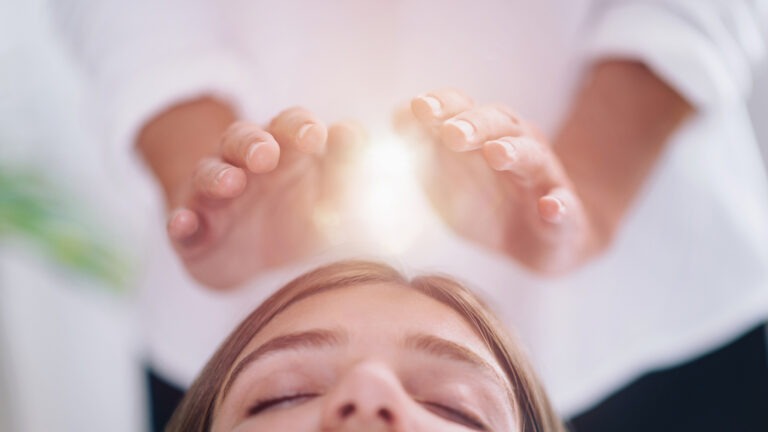
A groundbreaking new study shows that people with clairvoyant abilities can see energy healing take place. The implications for both the understanding of these extra-sensory abilities and the healing field- are profound.
The Institute of Noetic Sciences, or IONS, has just released the results of an important study that shows that energy healing works and that clairvoyants can pick up information about the healing by using their extended perception.
Dr. Helanè Wahbeh is the head of research at IONS and the study lead.
“Clairvoyance essentially is the experience of being able to see things around people — see within their body and around their body — and gain information in a way that is beyond our normal sight,” Wahbeh said.
“Sometimes this shows up as colors, sometimes people can see illness in other’s bodies; what might be called ‘medical intuition.’ Anyone can learn how to be a clairvoyant seer, in fact, there are people who teach medical intuitive classes. I’ve talked to many teachers who say ‘[A]s long as the person believes that they can, they can actually learn how to do this.’ That doesn’t mean that everyone is going to be excellent at it, but that the baseline level skill is learnable by anyone who is willing to try and believes that they can.”
Researchers sought to examine these abilities within the context of a study of Reiki, a popular Japanese energy healing modality. In the study, 40 participants with varying health issues were given half-hour Reiki sessions, which were then shown to improve their wellbeing. While the sessions were taking place, a group of six experienced clairvoyant seers observed.



